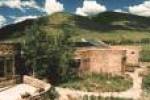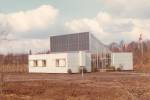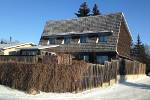The Pioneer Award
The world’s first-ever Passive House building was a milestone in energy efficient construction. Built in the early nineties, this project was only made possible by the work of pioneers in both research and practical application. To honour these ground-breaking achievements, the Passive House Institute has been presenting the Pioneer Award since 2011 during its International Passive House Conference. The award is presented annually to individuals who were setting new standards for energy efficiency in buildings, even before Passive House was on the scene.
The Rocky Mountain Institute
 The first Pioneer Award went to American physicist Amory Lovins in 2011. At an altitude of over 2,000 metres in Old Snowmass, Colorado, he built an extremely well insulated passive solar building in the eighties for the Rocky Mountain Institute, which he established. The experiences from this building provided the proof to Passive House researchers in Germany that the concept works in practice. In 1995, when visiting the first Passive House building in Darmstadt, Germany, Lovins encouraged that the concept not be regarded merely as a research project but as a viable energy standard for the future.
The first Pioneer Award went to American physicist Amory Lovins in 2011. At an altitude of over 2,000 metres in Old Snowmass, Colorado, he built an extremely well insulated passive solar building in the eighties for the Rocky Mountain Institute, which he established. The experiences from this building provided the proof to Passive House researchers in Germany that the concept works in practice. In 1995, when visiting the first Passive House building in Darmstadt, Germany, Lovins encouraged that the concept not be regarded merely as a research project but as a viable energy standard for the future.
The Philips Experimental House
 During the 2012 International Passive House Conference, the research of Bernd Steinmüller and his team was honoured with the Pioneer Award. In the wake of the 1973 oil crisis, these scientists conducted systematic energy efficiency studies in the Philips Experimental House. This test building in the German city of Aachen was equipped with excellent thermal insulation, a controlled ventilation system, a ground heat exchanger as well as solar and heat pump technology. The building was “occupied” by a computer which provided important results by means of monitoring. It was demonstrated that the implementation of passive measures alone could account for energy savings by a factor of 10 to 20.
During the 2012 International Passive House Conference, the research of Bernd Steinmüller and his team was honoured with the Pioneer Award. In the wake of the 1973 oil crisis, these scientists conducted systematic energy efficiency studies in the Philips Experimental House. This test building in the German city of Aachen was equipped with excellent thermal insulation, a controlled ventilation system, a ground heat exchanger as well as solar and heat pump technology. The building was “occupied” by a computer which provided important results by means of monitoring. It was demonstrated that the implementation of passive measures alone could account for energy savings by a factor of 10 to 20.
The DTU Zero-Energy Building
 The 2013 Pioneer Award went to the Technical University of Denmark (DTU) where scientists carried out ground breaking work on a zero-energy building. The building was constructed on a campus in Copenhagen and used for simulations and measurements for the optimisation of building components and building technology. Some of the employed technologies included a mobile thermal insulation in front of the windows, a heat recovery system for exhaust air and a solar heating system. The project was supervised by the late Professor Vagn Korsgaard, who passed away in 2012. Engineer Torben Esbensen, who played an integral part in the project, accepted the award at the International Passive House Conference in Frankfurt, Germany.
The 2013 Pioneer Award went to the Technical University of Denmark (DTU) where scientists carried out ground breaking work on a zero-energy building. The building was constructed on a campus in Copenhagen and used for simulations and measurements for the optimisation of building components and building technology. Some of the employed technologies included a mobile thermal insulation in front of the windows, a heat recovery system for exhaust air and a solar heating system. The project was supervised by the late Professor Vagn Korsgaard, who passed away in 2012. Engineer Torben Esbensen, who played an integral part in the project, accepted the award at the International Passive House Conference in Frankfurt, Germany.
The Saskatchewan Conservation House
 Following a break in 2014, where the Passive House Award was presented instead, the Pioneer Award was once again presented at the 19th International Passive House Conference. This time, a Canadian project was honoured: the Saskatchewan Conservation House, with which many features of the modern Passive House Standard were successfully tested in 1977. A broad team of experts looked at possibilities to significantly reduce the consumption of heating oil. Their studies showed that it was mainly a question of thermal protection of the building envelope. Canadian mechanical engineer, Harold Orr, one of the driving forces behind this project, received the Pioneer Award at the International Passive House Conference 2015 in Leipzig, Germany.
Following a break in 2014, where the Passive House Award was presented instead, the Pioneer Award was once again presented at the 19th International Passive House Conference. This time, a Canadian project was honoured: the Saskatchewan Conservation House, with which many features of the modern Passive House Standard were successfully tested in 1977. A broad team of experts looked at possibilities to significantly reduce the consumption of heating oil. Their studies showed that it was mainly a question of thermal protection of the building envelope. Canadian mechanical engineer, Harold Orr, one of the driving forces behind this project, received the Pioneer Award at the International Passive House Conference 2015 in Leipzig, Germany.
“Important Milestones”
“Today’s decision-makers often fail to recognise the importance of pioneering work, not only in the field of energy efficiency”, said Professor Wolfgang Feist, founder and director of the Passive House Institute, during the award ceremony in 2013. “The Pioneer Award is our contribution to keeping the memory of the most important milestones alive and to honour their significance accordingly.”
